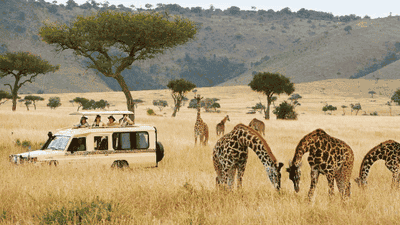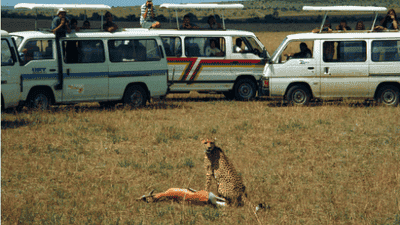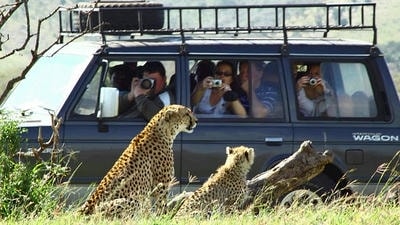
Ecotourism has emerged as a popular alternative to traditional tourism, often marketed as a sustainable travel option that emphasizes conservation and environmental awareness. The idea is simple: by exploring natural areas, travelers can contribute to conservation efforts and support local communities. However, the reality of ecotourism is more complex. While it has the potential to promote environmental stewardship, there is a growing body of evidence suggesting that, when poorly managed, ecotourism can do significant harm to wildlife habitats and ecosystems.
Ecotourism is defined by the International Ecotourism Society as "responsible travel to natural areas that conserves the environment and improves the well-being of local people." Key principles of ecotourism include:
The ecotourism industry has experienced exponential growth in recent years. According to the Adventure Travel Trade Association, the global ecotourism market has seen a near doubling in growth over the last decade. This increase can be attributed to several factors:
Rising Environmental Awareness: As public awareness of climate change and biodiversity loss grows, more travelers seek environmentally friendly alternatives to traditional tourism.
Demand for Unique Experiences: Travelers are increasingly drawn to authentic and immersive experiences that connect them with nature and local cultures.
Economic Incentives: Many countries recognize the economic potential of ecotourism and promote it as a means of generating revenue and creating jobs.

While the growth of ecotourism presents opportunities for conservation, it also comes with hidden costs. Unmanaged or poorly planned ecotourism activities can lead to serious negative consequences for wildlife habitats and local communities. Some key issues include:
Ecotourism can lead to habitat destruction in several ways:
Infrastructure Development: The construction of lodges, roads, and other facilities can result in habitat fragmentation and loss. This is particularly concerning in sensitive ecosystems like rainforests and coral reefs, where even small developments can have profound impacts.
Trail Erosion: Increased foot traffic on trails can lead to soil erosion and damage to plant life, making it difficult for vegetation to recover.
Resource Extraction: In some cases, the demand for natural resources (e.g., wood for construction, water for lodges) can result in overexploitation and degradation of local ecosystems.
Wildlife disturbance is another critical issue associated with ecotourism:
Stress and Disruption: Increased human presence in natural areas can stress wildlife, leading to changes in behavior, reduced reproductive success, and even abandonment of nesting sites.
Wildlife Feeding: Tourists often seek to get closer to wildlife, sometimes leading to practices like feeding animals. Such interactions can alter natural behaviors, making animals more dependent on human food sources and increasing the risk of human-wildlife conflict.
Noise Pollution: Sounds from tourist activities (e.g., vehicles, chatter) can disrupt animal communication, mating rituals, and foraging behaviors.
Overcrowding is a significant concern in popular ecotourism destinations:
Visitor Overload: Popular sites can become overwhelmed by tourists, leading to overcrowding that puts enormous pressure on local resources, including water, food, and sanitation systems.
Degradation of Visitor Experience: When destinations become overcrowded, the quality of the visitor experience declines, diminishing the essence of ecotourism.
While ecotourism can provide economic benefits, it can also have unintended negative consequences for local communities:
Cultural Erosion: The commercialization of local cultures to cater to tourists can lead to the erosion of traditional practices and values. Cultural commodification compromises the authenticity of local experiences.
Income Inequality: In some ecotourism ventures, profits may not be equitably shared among local communities. Often, external companies benefit disproportionately, leaving locals with minimal financial gains.
Dependence on Tourism: Reliance on ecotourism can create vulnerabilities, especially in times of economic downturns, natural disasters, or pandemics. Communities might find themselves ill-prepared when tourism declines.
To better illustrate the issues associated with ecotourism, let’s explore several real-world examples:
The Galápagos Islands are often hailed as a model for ecotourism. However, the surge in tourism has resulted in significant ecological challenges:
Invasive Species: Increased human activities have led to the introduction of invasive species that threaten native wildlife. For instance, introduced goats compete for resources with native species, while invasive plants displace local flora.
Infrastructure Impact: The construction of hotels and visitor facilities has resulted in habitat loss, as well as increased pollution in sensitive marine environments.
In Borneo, ecotourism activities have sometimes exacerbated the very problems they aimed to solve:
Deforestation for Ecotourism Resorts: Forests have been cleared to make way for luxury resorts that attract tourists seeking to experience the rainforest. This misalignment with conservation goals undermines the original intent of ecotourism.
Wildlife Disturbance: Increased tourist presence in remote areas has led to more frequent encounters with wildlife, altering animals’ behavior and stressing populations already threatened by habitat loss.
Yellowstone National Park is a prime example of ecotourism impacting wildlife:
Bison Management: The growing tourist numbers lead to increased human-wildlife conflict, particularly involving bison. As tourists flock to see these iconic animals, issues arise regarding their management and the stress placed on them during calving season.
Trail Erosion: The park’s popularity has resulted in trail erosion, degrading sensitive environments and affecting the plants and animals that inhabit them.

Given the challenges outlined above, it is essential to explore sustainable practices that can help mitigate the negative impacts of ecotourism:
Sustainable ecotourism begins with responsible planning:
Carrying Capacity Assessments: Conducting assessments to determine the maximum number of visitors that a particular area can sustainably accommodate is essential for preventing overcrowding.
Zoning: Implementing designated zones for tourism can help protect sensitive areas from direct human contact, allowing for the preservation of critical wildlife habitats.
Promoting low-impact tourism practices can significantly reduce the environmental footprint of ecotourism:
Eco-Friendly Accommodations: Encouraging the development of eco-friendly lodges made from sustainable materials and powered by renewable energy can help minimize ecological impacts.
Ecological Education: Tour operators should provide education to tourists about the local environment and wildlife, promoting responsible behaviors while engaging with nature.
Developing strong partnerships with local communities is vital for sustainable ecotourism:
Community Involvement: Involving local residents in decision-making processes related to tourism development ensures that their needs and wisdom are respected and integrated into ecotourism practices.
Fair Economic Distribution: Ensuring that a significant portion of the profits generated from ecotourism is reinvested in local communities can help alleviate income disparities and support community development initiatives.
Every ecotourism initiative should prioritize conservation goals:
Funding for Conservation: A portion of tourism revenues should be directed toward local conservation efforts. This funding can support wildlife monitoring, habitat restoration, and community education initiatives.
Wildlife Observation Guidelines: Establishing clear guidelines for wildlife observation can help minimize disturbance to animals. Tour operators should be trained to adhere to best practices that respect wildlife space and natural behaviors.
Shifting the model from merely sustainable to regenerative ecotourism can lead to positive impacts:
Restoration Projects: Engaging tourists in hands-on restoration projects—such as reforestation, habitat restoration, and clean-up programs—empowers them to contribute positively to the environment.
Fostering Biodiversity: Incorporating biodiversity conservation into ecotourism strategies can enhance ecosystem health while providing enriching experiences for travelers.
Ecotourism has the potential to be a powerful tool for conservation, education, and community empowerment. However, it is crucial to recognize the dark side of this industry—how well-intentioned travelers can unintentionally harm wildlife habitats and ecosystems. By understanding the complexities of ecotourism and embracing sustainable practices, we can work toward an ecotourism model that genuinely benefits both local communities and the environment.
As travelers, we bear a responsibility to make informed decisions about our travel choices, advocating for practices and policies that prioritize the health of ecosystems and the well-being of local residents. With awareness, responsibility, and commitment to sustainable practices, we can transform ecotourism from a potential harm to a source of healing and regeneration for our planet.